|
The Language of Stone.
(By Alex
Whitaker. Oct, 2013)
The Megalithic tradition has fostered numerous theories
concerning the skills, abilities, and above all the motives
behind working with almost impossibly large stones
around the ancient world. So remarkable are
the prehistoric achievements that they still cause
debate amongst scholars and laymen alike as evidenced by the
amount of literature available on the subject, but there is little to
explain the driving forces behind such extraordinary displays of
masonry and imaginative craftsmanship. This article therefore,
is an attempt to answer some of the questions of 'WHY' by exploring
the intimate relationship that developed over time between
people and stone, at the same time starting to decipher the
underlying lexicon hidden in these remarkable megalithic statements from
around the ancient world.
Although
today stone is primarily viewed as a building material, and for
sculpting statues etc, according
to Pausanias (VII, 24. 4), 'In olden times all the Greeks
worshipped unwrought stones instead of images'.
A statement which goes far to reveal the presence of a lost and
intimate form of communication that once existed
between people and stone itself. In order to understand this
apparent 'worship' of natural stone, the best place to start is
at the beginning of the human record and work forward to the
present.
It is
of course impossible today to accurately envisage how our earliest
ancestors viewed their place in the world. In terms of our
relationship with stone, we know that certain properties such as
strength and endurance had been recognised and utilised through the onset of
stone tool development c. 1 Mill years ago, a skill which
continued through to the Neolithic Age. These two basic
qualities laid the foundation for a relationship which can be
seen to have ultimately developed into an intimate and spiritual
union between people and stone, a tradition which still
has threads to this day in the shape of funerary head-stones
and our fascination with crystal energy, for example.
As with many
animals, we share an inbuilt tendency to see 'living' forms in natural objects. A phenomena known in biology as 'Imprinting'.
Nature has an uncanny way of replicating the human form in clouds, rocks,
and trees for example, and objects such as these are called
Simulacrum, or Anthromorphs. They have been
found associated with human remains for at least 2 Million years,
as evidenced by the Jasperite 'Makapango' pebble, found in
Africa in 1925. 'The pebble is interesting in that it was
found some distance from any possible natural source, in the
context of
Australopithecus africanus'
(1)
who existed between 2 and 3
million years ago.
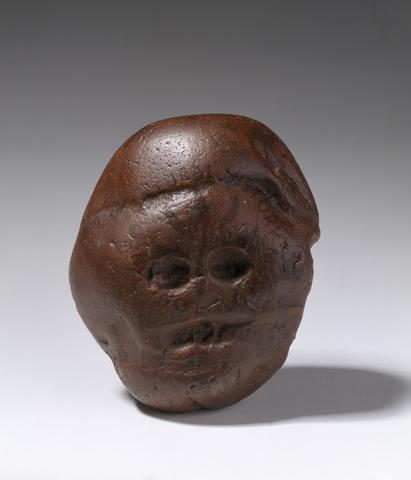
The 'Makapango' Pebble: The earliest known stone simulacrum
c. 2 - 3 Million years old.
From this
discovery alone, it appears we can reasonably conclude that humans both recognised and
valued a 'living' essence in natural objects, not just as a
weapon or tool but as something more. It demonstrates both
awareness and an attempt to connect (communicate) imaginatively
with the world we found ourselves in: Something which suggests
the first inkling of what could be loosely termed as a spiritual
awakening.
The
Palaeolithic shift was so dramatic, it has been recognised as representing
'an
evolutionary step of consciousness'. During this time, '...the
hominid brain tripled in size, peaking 500,000 years ago. Much
of the brain's expansion took place in the neocortex. This part
of the brain is involved in processing higher order cognitive
functions and is associated with self-consciousness, language
and emotion...' (2)
Most of the complex behaviours and
skills that
identify us as humans today followed this springboard of
imagination. Specialised tool making, exploring the arts with
music and lifelike paintings appearing in caves around the
world. Clothing, Burials and the way we lived all changed. In
respect of this, perhaps also a recognition of certain other
qualities of stone began to manifest. Crystals become more
frequent in association with human activity, as did
stones from far distances, with bright colours or other
qualities. It is also at
this time that a more intimate relationship with the earth can
be seen to begin through the apparent reservation of certain
underground cave systems for apparently ritual' purposes. Evidence suggests that this is
also the same period of time that our
relationship with psychoactive drugs and the living earth began. McKenna and others
(3) claim a direct connection between the two.
The large
number of painted caves from the Palaeolithic c. 50,000 - 20,000
BP is testimony to a function as yet little understood. There is
little doubt that we began to share a closer relationship with the
'living' earth at this time and in this respect, it is often
proposed that it [the Earth] represented the ultimate
'matriarch' or the 'Earth-mother'. Following this line of
thought, cave-entrances are suggested as being seen as a means
of entering into the very body/heart/womb of the Earth mother
itself. It is of interest to note that the oldest known
mine on archaeological record is the "Lion Cave" in Swaziland,
which radiocarbon dating shows to be about 43,000 years old.
(4) At this site,
Palaeolithic humans mined haematite to make the red pigment,
Ochre, which was so commonly used in cave art, decoration and
more importantly, in funerary rights around the world. We
can therefore see at this early time, both a high demand for
ochre and a distinction between mined caves, and those used for
'ritual' purposes. The prevalent use of red ochre in funerary
rituals and its later association with solar worship reveals
something of the nature of this apparently important commodity.
For example, the original cave entrance at Lascaux was naturally
orientated to receive the summer solstice sunset and the moon on
the winter solstice. (5)
While this cave system is
famous today for being adorned with images (painted in ochre),
there is no coincidence that this very same pigment was also
painted on the bones of the dead for well over 10,000 years.
(Palaeolithic
Wisdom)
Animating Stone:
The idea that
these early painted caves, stones and bones can be seen as representative of a
form of communication with the earth spirit/s herself is supported
by several facts. We have seen that people have a tendency to
see 'faces in the clouds' or 'simulacrum' in nature, and it is
likely that through Palaeolithic eyes, especially deep within
the earth in a ritual setting, such simulacrum would have
provoked a recognition of a 'life force' in nature, as though the
rocks were possessed by the animus spirit forms of the Earth
itself. There are several well known Palaeolithic Caves
where Simulacrum have even been artificially emphasised with paint so as to make them
more humanlike in appearance (Clottes & Lewis-Williams 1998:
90-91), and researchers
have now identified connections between both the locations of
Rock-art and Simulacrum (6), and Cave-art and
Lithospheres (Stones/rocks used for creating sound)
(6), offering
proof that Simulacrum were recognised and were chosen to be the
locations of 'Enforced Animation' or Idolatry. In this respect
we can begin to understand such groupings of investment in time
and energy as early communications with a 'Living
Earth', and therefore representing the beginnings of the reverence and worship of
Stone itself.
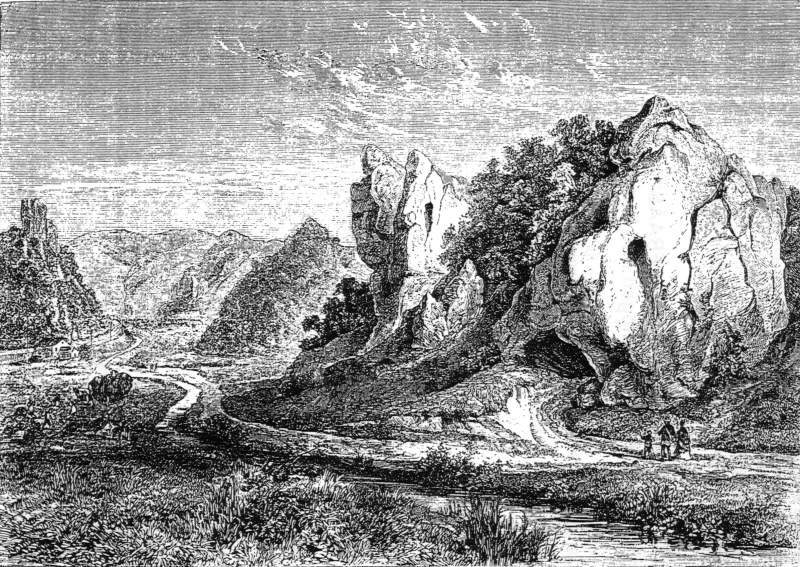
Image: (Hohle
Fells), Germany. Inhabited for over 10,000 years, c 40,000 -
30,000 BP.
The notion of rocks �behaving� in
human-like ways is a religious phenomenon with an extremely wide
geographical distribution (6). Rocks have been perceived to be alive
by numerous peoples living on all continents, including the Saami,
the Ojibwa of North America (Hallowell 1960) and the Nayaka of
South India (Bird-David 1999), to mention but a few examples. The
act of 'Enforced Animation' on natural objects may today seem
somewhat 'primitive', but to our Palaeolithic ancestors such
acts were likely deemed of great spiritual significance. The
recognition of 'spirit' forms in nature and the subsequent
attempts to communicate with them is an important part of the
human journey, and one which has its roots in all modern
religious doctrines. The following demonstrates how such beliefs
have been carried through history to this very day:
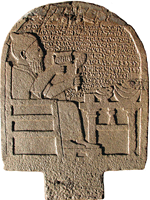 (Right)
- Eighth-century B.C. funerary stele unearthed at the site
of Zincirli in south-eastern Turkey: Translation by the University of Chicago's Oriental Institute recently announced a
translation of the monument's 13-line inscription, which is emblazoned
beside a depiction of the deceased, a high official named Kuttamuwa. (Right)
- Eighth-century B.C. funerary stele unearthed at the site
of Zincirli in south-eastern Turkey: Translation by the University of Chicago's Oriental Institute recently announced a
translation of the monument's 13-line inscription, which is emblazoned
beside a depiction of the deceased, a high official named Kuttamuwa.
The text states that Kuttamuwa fashioned the stele during his
lifetime, and that at its inauguration in the mortuary chapel offerings were
made to various gods, including the storm-god Hadad and the sun-god Shamash.
Of particular interest is the line which explains that one
of the offerings was "a ram for my soul that is in this stele." which
clearly suggests that the stone served as a vessel for his soul.
Archaeoacoustics:
The association
of cave-art and areas of acoustic significance has paved the way
for a whole new branch of research, namely 'Archaeo-acoustics',
which is the study of human relationship with sound in
prehistoric settings. The numerous discoveries of 'Bone
Flutes' from around the ancient world have testified to the
fact that not only did Palaeolithic people use the same diatomic
scale as we do today (Do, Ray, Me... etc), but from their
settings, that music and sound played an important, even
ceremonial part of their lives.
The importance
of sound as a means of communication is unquestionable, but its
function deep within the earth, in the darkest, sometimes
almost impossible locations is something that we have yet to find a
satisfactory answer for. Evidence for the use of lithic (Lithophones) objects
in the Upper Palaeolithic to produce sound can be found in Dams
(1985). These reports concern the exploitation of stalagmitic formations,
which afford differently pitched sounds when struck in caves in France (Roucadour, Cougnac, Pech-Merle), Spain (Nerja)
and in Portugal (Escoural). Dams indicates that many of these lithophones are decorated or
marked, often with red ochre dots, indicating an intentional and repeated use for sound production
which (op. cit, p32) "can be observed by the traces of blows,
damaging or chipping the surface". It has also been shown by the musicologist I�gor Reznikoff
(1995), that echoing was an element
that influenced the location of prehistoric rock-art. (6)
In fact, so great is the association between Simulacrum and Cave Art / Cave
art and Lithospheres (eg: Hohl Fells, Altamira, Les Trois Freres, Gargas, Le Tuc-d'Audobert, Nerja - The 'Organ'),
that one is forced to consider what the common factors are that
unite them.
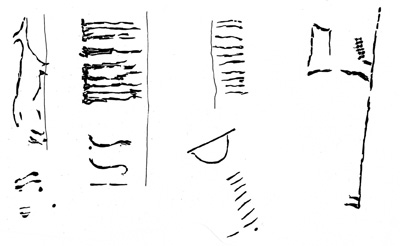
Examples of
Palaeolithic Markings on Lithophones.
(8)
It has long
been suggested that these isolated sanctuaries deep within the earth, with all the stated
associations (lithophones, cave art, simulacrum) were frequented
predominantly by 'Shamen'. If, as it is suspected, these cave
systems were considered as giving us a literal and physical
access to the 'earth-mother' herself, then it is a reasonable
assumption that any form of 'communication' that took place at
these locations was designed to be with the 'spirits' or
'animus' that resides both within us and surrounding us. In this
respect, it should be noted that there are several modern
studies on the effects of vibrations and harmonics on the human
brain which suggest that sound can trigger neurological
responses in humans which can lead to both auditory and visual
hallucinations, a finding which has considerable implications in
relation to the proposal of the shamanic experience of
communication.
Arguably the most basic rhythm of life
lies in the heartbeat itself. What does the heartbeat tell us.? In its most basic sense, it
reminds us
that we are alive. It repeats the message to us, reinforcing it for
our entire existence. In this respect, the concept of
'reinforced animating' takes on a new meaning, and one which
proposes the idea that people were not only communicating
through sound, but that this sound was considered as an
confirmation of the beating heart
of the earth itself. The acoustic properties of sound are now
understood to have a substantial effect on their
surroundings. Vibrations and harmonics are well known to be able
to shatter glass for example, and recent experimentation in the
field has resulted in the development of 'sonic tools', and even
the levitation of objects (in the lab)
(7).
Of particular interest in respect to this article however, are
the effects of sound on the human brain, especially in the
region of 110Hz, which is known to trigger a specific set of neurological responses.
(More
about Archaeoacoustics)
Auditory Hallucinations:
We can see elements in both the Palaeolithic and Neolithic which
suggest altered state activity. This state of mind is one during
which certain recognised boundaries become blurred by both
physiological and psychological changes. The simple act of
repetitive drumming for example, is known to induce such altered states
including auditory hallucinations. Modern experimentation has
shown that in schizophrenia, sleep deprivation, hypnogogia, meditation and drug induced
altered states, voices are a common experience. These auditory
hallucinations have often been described as the 'Voice of God',
or the 'Inner voice', something which becomes extremely relevant
in our search for the origin of stone worship, as if these
places were selected or designed for their acoustic qualities as
research suggests, then the subjects communication process would
appear in these conditions to seem complete.
Unfortunately, there is little scientific literature on the
shamanic altered-state per se, but the experience of
hallucinating isn't just restricted to spiritual practices. On
the contrary, similar experiences are widely recorded by people
who experience hallucinations which are often auditory or have an auditory
component. Hypnagogic sounds vary in intensity from faint
impressions to loud noises, such as crashes and bangs (exploding
head syndrome). People may imagine their own name called or a doorbell ringing
and snatches of imagined speech are common. While typically
nonsensical and fragmented, these speech events are entirely
real to the person experiencing them. More rarely, poetry or
music is heard. The range of natural triggers for auditory
hallucinations make it feasible that humans experienced such
things in the Palaeolithic past, although likely responding to
them differently than we do today as modern science is more
interested in 'alleviating' such auditory hallucinations, and
has found several means of doing so.
(9)
(More
about Shamanism)
'The Worship' of
Stone.
For a long time
now, we have referred to the 'Megalithic' period as one during
which people began to build with 'Large Stones'. However, this
explanation is no longer sufficient to explain the fantastically
sized stones used on occasion (over 1000 metric Tons in cases)
(10),
the meticulous carving between adjoining stones, or the
incredible distances stones were transported to their final
resting places. These facts require a more sophisticated
rationale to justify their presence and that is exactly what we
find in the propositions above. Our relationship with stone,
when viewed though Palaeolithic eyes, appears to have been a
combination of both function and reverence. The creation of
'sacred places' within the living earth itself, and the
suggestion of 'altered states' by the people frequenting them
finds echoes in the later Sybils of the Greeks, who were also
both strongly associated with intoxication and a connection to
the realms beyond.
In relation to
this article, the Mesolithic and Neolithic periods signify the
transition from using natural, internal cave
systems, to artificial, external stone monuments. The
remains of this megalithic phenomena left us an important
set of clues through which we are still able to communicate with
the builders today. We have discussed the idea that stone held a
unique significance to our prehistoric ancestors, and that they
were attempting to communicate something for which stone (the
earth) itself came to represent the rudiments of a 'religious'
'lexicon'. In this respect, the megalithic structures can be
seen as extensions of the inner/outer communication we
experienced as a result of a raised consciousness.
If these
monuments (stones) are a form of communication, what do they
have to say to us.?
The specific
selection of different types of stone, arrangements,
orientations, placement in landscape and design can all be seen
as parts of an ancient language spoken to us by the builders. Each stone
representing a 'word'
or memory, and the 'words' placed together making statements and
connections. It has been recognised that a large number of
megalithic sites have stones which are clearly 'anthromorphic'
or 'simulacra', the very same association found within the
Palaeolithic caves. These 'animated' stones undoubtedly still had a meaning to the
Mesolithic and Neolithic peoples and it can be assumed that they
acted as some form of physical or metaphysical
bridge simultaneously connecting us (through our presence) both to the heavens
(through their orientations), the living landscape
and perhaps more importantly, to each other.
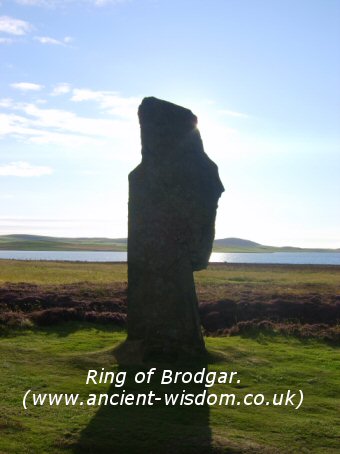
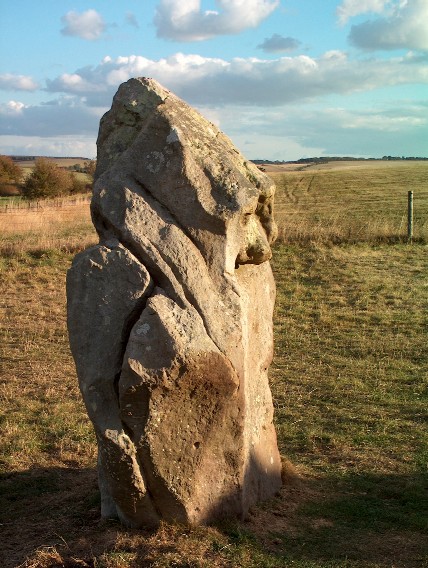
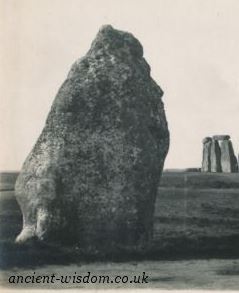
Examples of
Simulacrum at Neolithic Sites: (From left to right - Brodgar,
Avebury, Stonhenge)
Other qualities
of stone which were recognised by the ancients and employed in
their structures also testify to a continued 'worship' of stone
itself. For example, the 'magical' qualities of stone were
presumably considered worth the effort of transporting the Stonehenge Bluestones
hundreds of miles (traditionally associated with both healing
and acoustics), and 'Sky stones' were revered by the
ancients as testified to this day by the Kaaba at Mecca,
suspected of being of meteoric origin.
(11)
The Bible talks of Lot
casting stones over his shoulder which turn into people and
there is a clear metaphysical connection between people and
stone to this very day in the shape of headstones 'The
carriers of the soul' and the continued belief in crystals
as a source of 'power' or means of 'channelling energy'.
What we begin
to see in our relationship with stone is that it has acted as a
metaphysical bridge both in life and death. Our transfer from
worshipping directly within the heart of the earth in stone
chambers to building symbolic representations of these
metaphorical 'wombs' into the landscape (passage mounds, dolmens
etc), we still take comfort today in gathering (worshipping)
within now geometrically perfect, yet still stone built Churches
and Cathedrals (such as Chartres in France for example, which
was designed for optimum resonance, believed to bring people
closer to God on the basis that perfect resonance equals
Ecclesiastical bliss). So that while the setting has changed,
the song remains the same.
(Simulacrum)
(The Living Earth)
(The
Top-50 Megaliths of All Time)
|


 (Right)
- Eighth-century B.C. funerary stele unearthed at the site
of Zincirli in south-eastern Turkey: Translation by the University of Chicago's Oriental Institute recently announced a
translation of the monument's 13-line inscription, which is emblazoned
beside a depiction of the deceased, a high official named Kuttamuwa.
(Right)
- Eighth-century B.C. funerary stele unearthed at the site
of Zincirli in south-eastern Turkey: Translation by the University of Chicago's Oriental Institute recently announced a
translation of the monument's 13-line inscription, which is emblazoned
beside a depiction of the deceased, a high official named Kuttamuwa.

